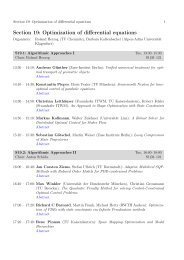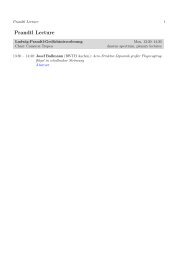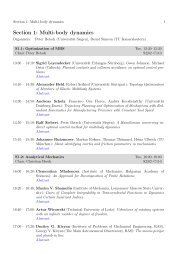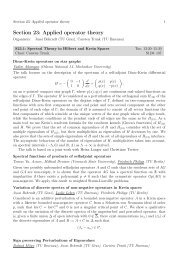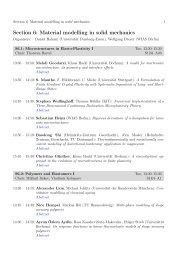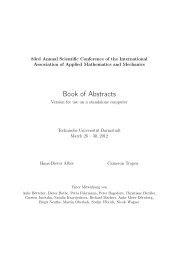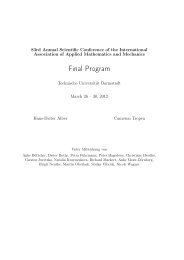Section 6: Material modelling in solid mechanics - GAMM 2012
Section 6: Material modelling in solid mechanics - GAMM 2012
Section 6: Material modelling in solid mechanics - GAMM 2012
You also want an ePaper? Increase the reach of your titles
YUMPU automatically turns print PDFs into web optimized ePapers that Google loves.
28 <strong>Section</strong> 6: <strong>Material</strong> <strong>modell<strong>in</strong>g</strong> <strong>in</strong> <strong>solid</strong> <strong>mechanics</strong><br />
modulus. The Molecular Mechanics method orig<strong>in</strong>ates <strong>in</strong> the <strong>in</strong>vestigation of the properties of<br />
big molecules which due to their size cannot be handled by quantum mechanical methods. In<br />
Molecular Mechanics the behavior of the covalent bonds <strong>in</strong> a S<strong>in</strong>gle Wall Carbon Nanotube is<br />
represented by a set of potentials. Here every s<strong>in</strong>gle potential expression describes a correspond<strong>in</strong>g<br />
bond deformation. As a result of the description of the bonds by potentials, the force act<strong>in</strong>g<br />
between the atoms can be calculated as the derivatives of the potentials with respect to their<br />
correspond<strong>in</strong>g displacement variable. Hence, the Carbon Nanotube is modeled by po<strong>in</strong>t masses<br />
represent<strong>in</strong>g the carbon atoms and a set of spr<strong>in</strong>gs or beam elements represent<strong>in</strong>g the bonds. Regard<strong>in</strong>g<br />
Multi Wall Carbon Nanotubes this model can be extended by add<strong>in</strong>g the van-der-Waals<br />
<strong>in</strong>teractions, described by another potential.<br />
Dur<strong>in</strong>g the process of model<strong>in</strong>g and also dur<strong>in</strong>g the evaluation of the results we have to rise<br />
several challenges. S<strong>in</strong>ce the Molecular Mechanics method is a so called semi-empiric method we<br />
have to choose between different sets of potentials. Some of these potentials - lead<strong>in</strong>g to l<strong>in</strong>ear<br />
or nonl<strong>in</strong>ear behavior of the <strong>in</strong>teraction forces between the atoms - are <strong>in</strong>vestigated regard<strong>in</strong>g<br />
their advantages and disadvantages. In order to illustrate this we compare the (theoretical) results<br />
available <strong>in</strong> literature with our numerical results, which we obta<strong>in</strong> by us<strong>in</strong>g the model to<br />
conduct a virtual tensile test. The dependance of the Young’s modulus on type and diameter of<br />
the Carbon Nanotubes is discussed.<br />
Dislocation Dynamics <strong>in</strong> Quasicrystals<br />
Eleni Agiasofitou, Markus Lazar (TU Darmstadt), Helmut Kirchner (Leibniz Institut für neue<br />
<strong>Material</strong>ien, Saarbrücken)<br />
In this work, we present a theoretical framework of dislocation dynamics <strong>in</strong> quasicrystals [1] accord<strong>in</strong>g<br />
to the cont<strong>in</strong>uum theory of dislocations. Quasicrystals have been discovered by Shechtman<br />
et al [2] <strong>in</strong> 1982 open<strong>in</strong>g a new <strong>in</strong>terdiscipl<strong>in</strong>ary research field. A comprehensive presentation of<br />
the current state of the art of this research field, focused on the mathematical theory of elasticity,<br />
can be found <strong>in</strong> the recently published book of Fan [3].<br />
We start present<strong>in</strong>g the fundamental theory of mov<strong>in</strong>g dislocations <strong>in</strong> quasicrystals giv<strong>in</strong>g<br />
the dislocation density tensors and <strong>in</strong>troduc<strong>in</strong>g the dislocation current tensors for the phonon<br />
and phason fields, <strong>in</strong>clud<strong>in</strong>g the Bianchi identities. In the literature, there exist different versions<br />
of generalized l<strong>in</strong>ear elasticity theory of quasicrystals. The difference of these versions lies <strong>in</strong> the<br />
dynamics of phonon and phason fields. In the present work, we deal with the elastodynamic as well<br />
as the elasto-hydrodynamic model of quasicrystals. Accord<strong>in</strong>g to the first model, the equations of<br />
motion are of wave-type for both phonons and phasons while accord<strong>in</strong>g to the second model the<br />
equations of motion for the phonons are equations of wave-type and for the phasons are equations<br />
of diffusion-type. Therefore, we give the equations of motion for the <strong>in</strong>compatible elastodynamics<br />
as well as for the <strong>in</strong>compatible elasto-hydrodynamics of quasicrystals.<br />
We cont<strong>in</strong>ue with the derivation of the balance law of pseudomomentum thereby obta<strong>in</strong><strong>in</strong>g<br />
the generalized forms of the Eshelby stress tensor, the pseudomomentum vector, the dynamical<br />
Peach-Koehler force density and the Cherepanov force density for quasicrystals. Moreover, we<br />
deduce the balance law of energy that gives rise to the generalized forms of the field <strong>in</strong>tensity<br />
vector and the elastic power density of quasicrystals. The above balance laws are produced for<br />
both models. The differences between the two models and their consequences are revealed. The<br />
<strong>in</strong>fluences of the phason fields as well as of the dynamical terms are also discussed.<br />
[1] E. Agiasofitou, M. Lazar and H. Kirchner, Generalized dynamics of mov<strong>in</strong>g dislocations <strong>in</strong><br />
quasicrystals, J. Phys.: Condens. Matter 22 (2010), 495401 (8pp).<br />
[2] D. Shechtman, I. Blech, D. Gratias and J. W. Cahn, Metallic phase with long-range orienta-



